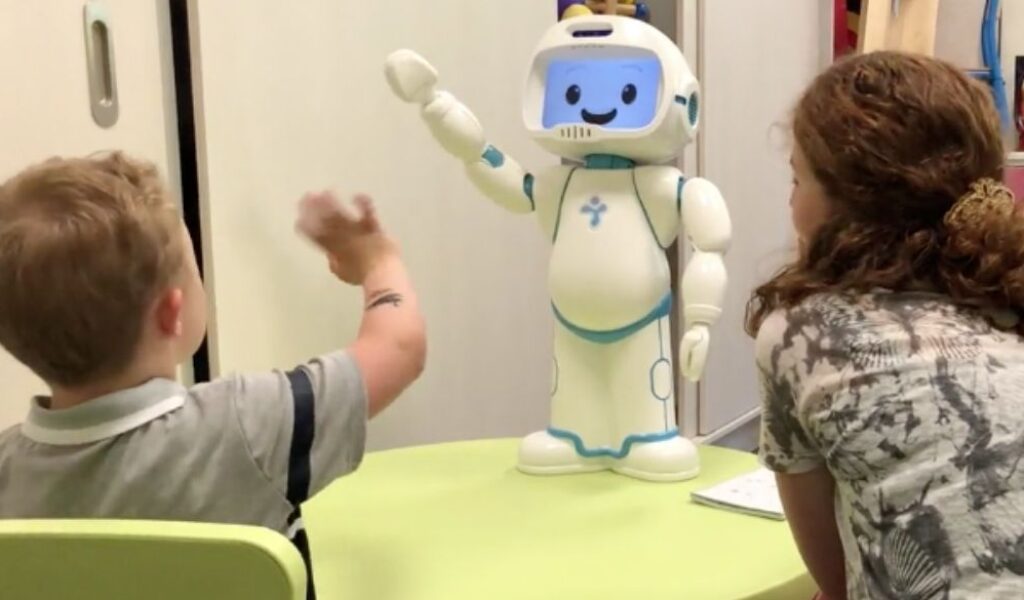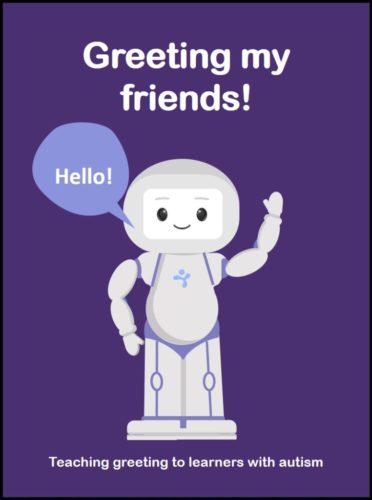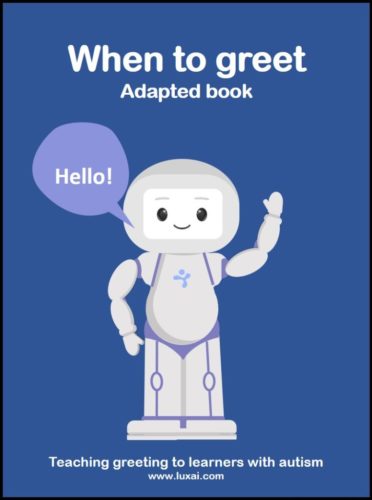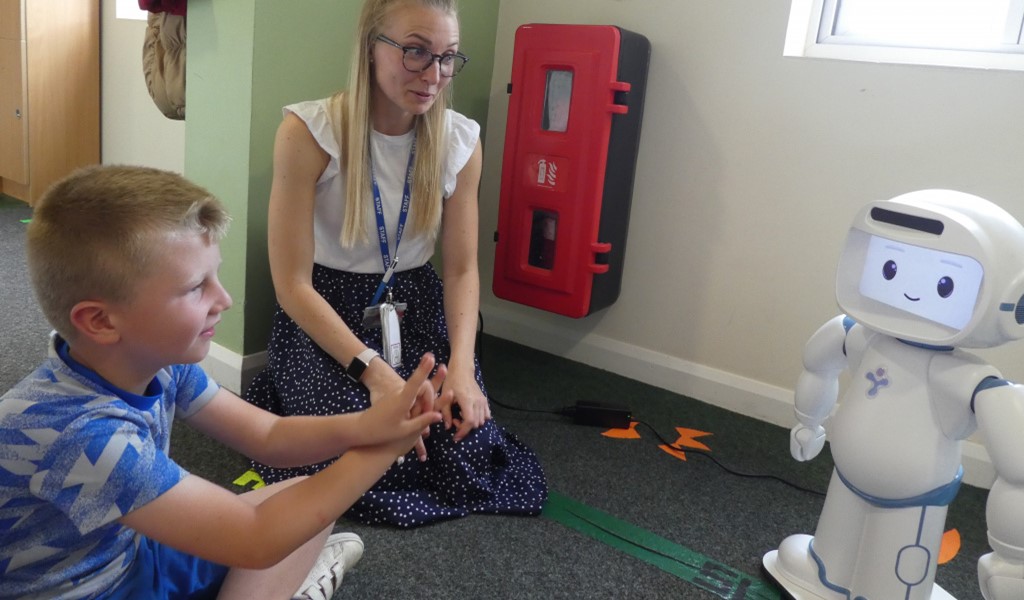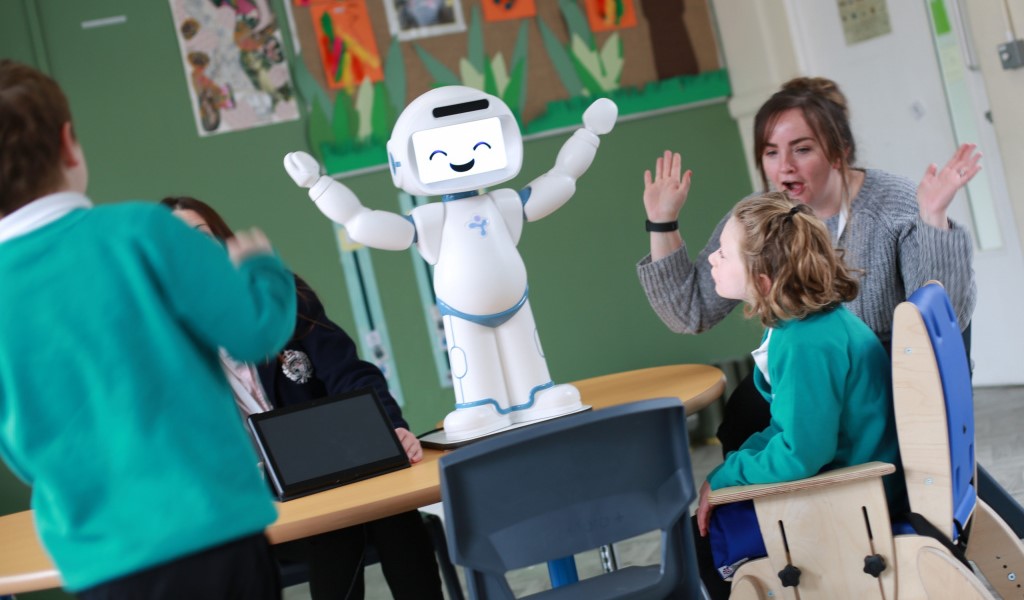Children with autism can have challenges in social skills and, in particular, using language for social interaction. People familiar with children with ASD know that it’s often easier to teach kids to use language for requesting than to use language for other types of communication, such as speaking about likes and dislikes or past events. In many cases, without direct teaching, children with autism tend to avoid social interaction and will not acquire the skills required to integrate into society, make friends and attend school. This is sometimes assumed to be a lack of social motivation on the child’s part, but it can simply be because they don’t know how to engage in a successful way with other people.
Why to start teaching greeting to children with autism:
Greeting by waving hi and using simple vocabulary like “Hi” or “Hello” may seem trivial because it is one of the first social mile stones seen in typically developing kids. However, in kids with autism we often see delayed or absent early social greetings. This may be because the child has not yet learned to seek out social interaction or because some other key skill such as imitation or joint attention is not learned.
Teaching greeting is absolutely important because it is the first step for initiating with and responding to other people in almost every setting. That’s why teaching greeting is a great step to start with social skills training, success with greeting can lead to motivation to engage with other interactions.
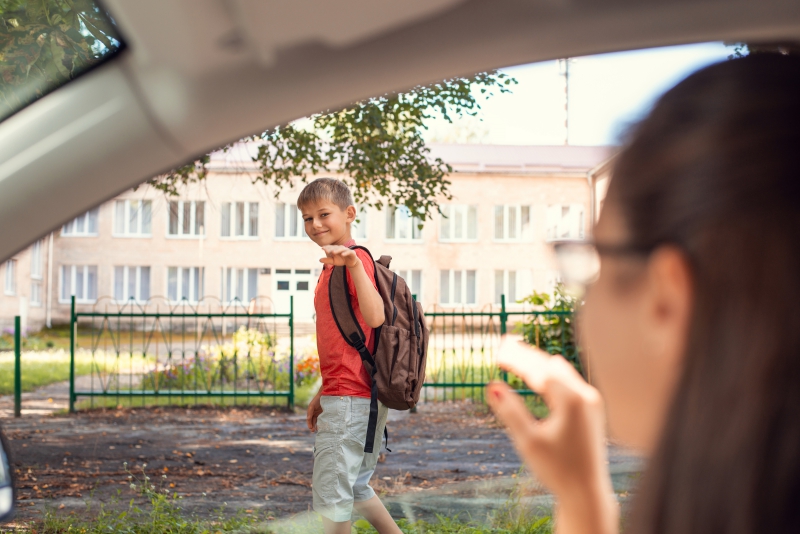
Teaching greeting to children with autism can also be relatively easy compared to teaching other communication and social skills. This is largely because greetings are routine and predictable. It is reasonably easy to create a simple plan for a child telling who, when, and where to greet people, and also when not to greet people. Also, no matter how greeting is initiated by others, a set of greeting words can be used in response.
Greetings can indeed be easily taught, but there are some important prerequisite skills you should think about before you begin teaching.
To respond to a greeting, first it’s important that a child looks when they hear their name. if they are responding to their name reliably, great, you can start to teach greeting. If not, start on this skill first. To teach a child to initiate a greeting, a good prerequisite skill to teach is a non-verbal approach or initiation to another adult or child. If these skills are in place, then you can go ahead and teach your child to greet other people.
Now that we know the value of teaching greeting and we know that they can be thought to autistic kids, let’s look at some practical tips and steps to establish greeting skills in learners with ASD.
10 tips and steps for teaching greeting to children with autism:
1- First practice greeting with familiar people and familiar environments and help the child to establish the required vocabulary and gestures:
It can be too demanding for kids to practice greeting in situations that are unfamiliar for them. That’s why it is best to start practicing greeting with parents and teachers in the familiar environment of the classroom or when arriving at home. Try to help your child to learn how to imitate waving hi and how to say hi or hello first.
Practicing basic greeting at home with children with autism
2- Build greeting into your child’s routine:
Try to incorporate greeting in to a natural routine. Make the greeting a part of the morning routine or afternoon routine and practice greeting whenever it is appropriate for the situation.
3- Start from just a few greeting ways and words:
At the beginning it’s not necessary to use all the greeting words or gestures. Just pick a simple one, like “Hi” to begin with. This way your child will not be confused by having many choices and can be more relaxed around greeting. Also, try to use simple waving as a simple demonstration for greeting. Waving hi is a good way of greeting for young children as well as non-verbal kids.
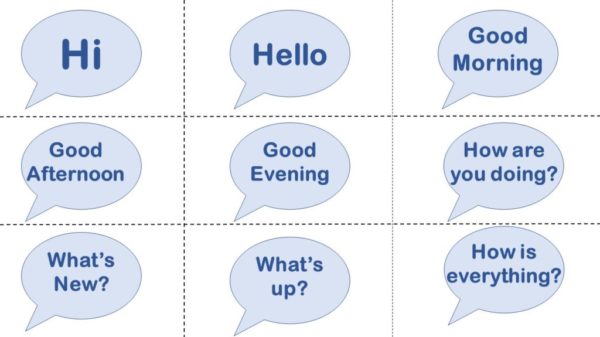
4- Use greeting visuals:
Children with autism often learn better when a social concept is visualized for them. Using visual cards can help kids to better understand greeting and other social activities. Also try to use the visuals in the locations that the greeting is going to happen. For example, when a child enters home, right close to the door, is a great location to set up some visuals so your child will get prompted to greet, when he arrives at home. The visuals can be used in the entrance of the school or close to the classroom door as well.
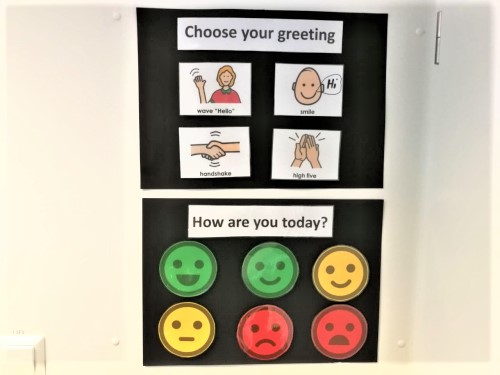
Using visuals at the entrance to prompt greeting in children with autism
Using visuals can be a good help for verbal kids but it can be a great tool for our non-verbal kids. Non-verbal kids can learn to use the same visuals to greet and to respond to greeting. You can help your non-verbal kid to respond using their speech generator apps.
When using visuals don’t forget to pair the visuals with the greeting so your child can understand the connection.
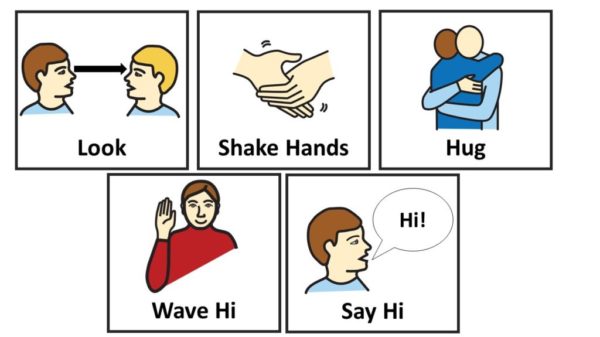
Using visual support and stimuli for teaching greeting to children with autism
5- Video modelling:
Another way to visualize greeting is to use video modelling. Video modelling is one of the evidence-based practices for autism allowing children to learn by observing other people performing the action.
Video modeling example for teaching greeting to children with autism
6- Use social narratives to explain why, when and how we greet people:
It is important to help kids with autism to understand why they should greet people or respond to other greeting them. Also it is important to break the greeting in to a set of actions that they can learn to do as a routine. For this purpose you can use social stories which is another evidence-based practice to help children with ASD. Social stories use simple visuals and easy to understand sentences to establish a social concept and provide a step-by-step guide for children to deal with the social situation. There are many social stories available that you can use to teach greeting.
7- Practice with adapted books:
After explaining why, when, where and how to greet and demonstrating greeting ways, you can further practice situations and greeting ways through using adapted books and task cards. For example, you can use adapted books to help your child to pick the right greeting for different scenarios and to choose when to greet and when not to greet.
8- Plan for generalization:
Just like any other skill, the ultimate goal of teaching greeting is that the child generalizes the learnt skill to interactions with others, to novel environments, and uses the skill in their daily life routines. That’s why focusing on generalization is very important to ensure social success. We can involve peers, siblings, or classmates in teaching greetings to ensure the learner gets more attempts each day with people their own age. Ideally, we can also teach the child a greeting used by their peers, to keep things age-appropriate (see point 10).
9- Make it engaging:
Engagement is critical for learning. At the beginning your child may not like to practice greeting. In this case you have to find a way to make practicing more motivating. There are many ways to incentivize your child to practice, so use one that you know your child will like. When starting to teach greeting, you should over-respond to any successful initiation by your child. If they look and wave, or even just look at you when you enter a room, you’ve got to make it clear that this is super important.

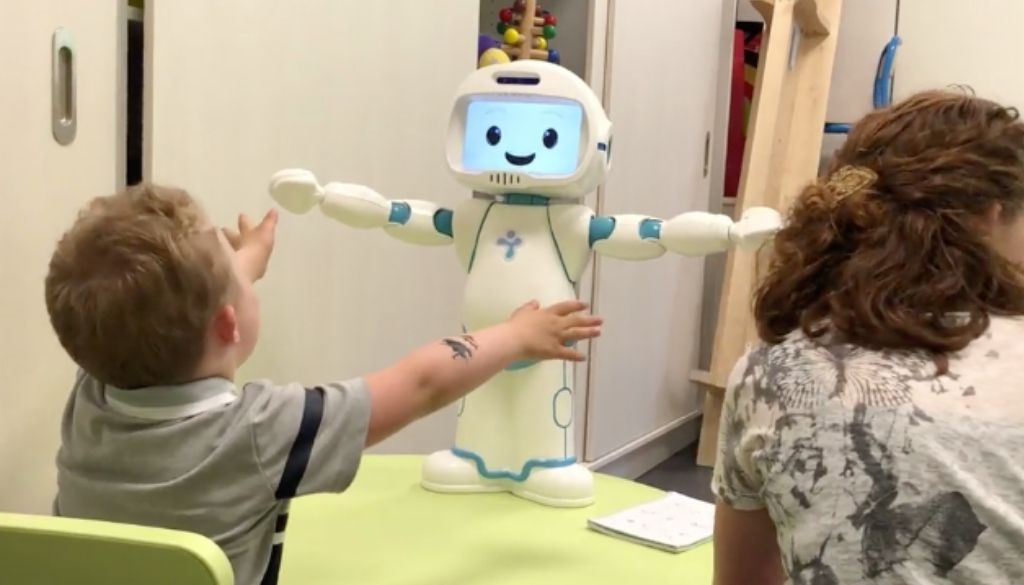
QTrobot using engaging reinforcement when the child greets
Respond socially, get down to your child’s level, (if they’re little), and give a hug, tickle, high 5, or any social interaction you know they really like. If your child doesn’t have these as motivators you can sing to them, watch a short clip of a favorite video together, or play with them and their favorite toy. It’s important to have these items handy if you’re planning to use them as motivators, timing is crucial.
Over time, you can fade back your over-responding when your child is greeting you fluently. Then you can plan to over respond to ‘hello’, ‘how are you?’, or whatever your next greeting goal is.
Over time you can also fade out the music and toy motivators as the social motivation starts to emerge.
10- Don’t forget to make it age appropriate:
In normal life, people from different age groups greet differently, so don’t forget to teach greetings that are appropriate for the age of your child. This will allow your child to greet peers in the most natural manner. For example, a wave or fist bump may be more common among children than a handshake. As your child gets more advanced they can learn the difference between greeting a child and adult, and more casual or formal greetings, depending on the situation.
Ensure the adults around the child know what stage of teaching the child is at. For example, responding to greeting might be taught before initiation of greetings, and greeting a peer might be taught differently to greeting an adult.
For initiating greetings, make sure they know how to prompt the greeting, to wait for the student to initiate, and how to reinforce both steps. This includes making sure that peers know how to do this too to increase success with them.
For each child, determine an appropriate method of communication for greeting peers. You will need to individualize this. Don’t have everyone use a visual if half of your students can talk. And don’t leave out your child who is nonverbal by not having an appropriate communication system for him. It’s all about individualization. It’s also all about balance. We want to push our kids to utilize the highest level of communication they can do but we also don’t want to make it so challenging that they give up immediately. Think outside the box. Use visuals, AAC devices, or hand gestures if needed!
QTrobot, interactive robot for teaching social skills to children with autism:
QTrobot is a little child-like robot designed to increase the attention of learners with autism and help them to practice skills related to social-emotional development as well as language and cognitive abilities.
QTrobot has several units for teaching and practicing greeting with children with autism and special needs education. The lessons are structured as simple and short games, allowing children to practice various important areas related to greeting through playing with the little robot.
Practicing personal distance for greeting and communication with QTrobot
QTrobot practices greeting in an age-appropriate and step by step manner, helping children to learn how to respond to greetings, how to use various gestures to greet others, and learn when to greet and when not to greet.
To learn more about QTrobot activities for teaching social skills and greeting, check out the educational curriculum outlines from here!
